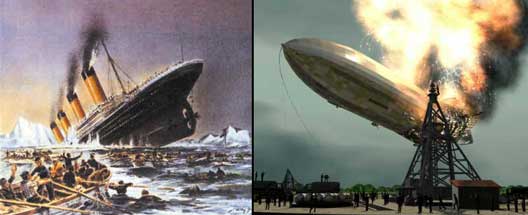Titanic & Hindenburg: Two Psy-Ops, One Agenda?
June 24, 2010
 by "Watchdog"
by "Watchdog"(for henrymakow.com)
The sinking of the world's largest ship on her maiden voyage in 1912; and the spectacular fireball and "explosion" of the giant German airship in 1937. Could these two events be related? Each tragedy serves as a distinct marker: the beginning and ending of an era in which transatlantic passenger transportation underwent a colossal transformation.
In August of 2005, two independent divers, using the Finnish-built deep water MIR submarines, found two new parts of the bottom of the hull of Titanic separate from the hull and stern at the bottom of the Atlantic. That means that this great unsinkable ship, which hardly nudged an iceberg, somehow broke itself into four pieces before leaving the surface of the ocean. Maybe it's time to consider the possibility of foul play?
Were both the Titanic and Hindenburg part of a plan to convert the world's means of passenger transportation from safe and luxurious ships to cramped, noisy and extremely dangerous aviation aircraft that use huge amounts of petroleum fuel? During this era, a conversion of cheaper and alternate fuels, used formerly in steamships, to the high octane fuels, used by the emerging passenger aircraft industry was accomplished, resulting in profits beyond measure.
The period from July 31, 1908 when Joseph Ismay signed the order to have the Titanic built until March 26, 1939 when transatlantic passenger travel via fixed wing aircraft was inaugurated, is the era of Titanburg.
During World War One, huge investments were made in the manufacture of aircraft engines which allowed the Illuminati bankers to stipulate that all aircraft engines use petroleum as the sole source of fuel. The final coup de grace: Burn the Hindenburg to give the world a reason to forget all about airships (as they consume much less fuel). And so petroleum, which had sold for pennies per barrel at the turn of the century was soon to be marketed at 100 times the cost.
Today we still use petroleum (kerosene called jet fuel) in all of our aircraft even though it burns and explodes, yet we have been sold the idea that hydrogen is so dangerous that it can't be used.
TITANIC CONTRADICTIONS
New steamships had to be broken in during their maiden voyage. They were not able to make good speed during their first two days out. So the idea that Titanic tried to set a speed record on her maiden voyage doesn't make sense. In fact, she was way behind a Cunard liner, which had more horsepower anyway.
Firsthand reports and testimonies in hearings held shortly after the disaster indicated that if the ship struck the iceberg at all, it continued to slip on past the iceberg. There certainly was no jolt. Shortly thereafter a disastrous leak was found that indicated five watertight compartments had been breached. Two hours and forty minutes later, the great ship pivoted until it pointed straight down toward the bow, and then slipped beneath the water. This was the testimony of the first officer of Titanic in a US court of Inquiry which was held days after the tragedy.
It never made sense to me that a seasoned captain such as Capt. Smith would have gone storming through an ice field. Then, there was the lack of a real collision with the iceberg itself, yet the damage done was so extreme, or was it? All the testimonies given in both the United States and later Great Britain board of Inquiries reveal that not one passenger was sure s/he felt a collision.
Today, we have the benefit of more information about this tragedy. First, in 1982 the two Mir submersible submarines came into being, and by 1985 the Titanic wreck had been located and filmed. The wreck of the Titanic was in two pieces.
In 2005, another expedition organized by two American divers, Chatterton and Kohler, found two never-before-seen large sections. They were nearly a mile away from the forward and rear pieces of the hull! These large sections span the bottom of the ship from port to starboard, through both the inner and outer hulls.
Each piece is over thirty feet in length and the width of the beam of the ship which is 92 feet. That these new pieces came loose from the main hull of Titanic at the surface. They could not possibly have come off from the force of the Titanic hitting the ocean floor. They are too far from the hull and stern!
We now have to explain a ship that hardly touched an iceberg yet is in four pieces on the bottom of the ocean!
Keep in mind, these sections are from the very bottom of the Titanic and represent hundreds of tons of steel. Each near-rectangular section is made out of 1" thick steel plate, top and bottom (two separate layers 1" thick) separated by the athwart-ship ribs that are five feet in height. In other words, there was a space of five feet between the inner and outer hulls of the bottom of the Titanic, and both are 1" thick plate steel.
Both of these are sheared through right along the edge of the ribs, all the way across the bottom from port to starboard!! So we have two double hulled hollow sections, each about 30 feet by 92 feet, enough area lost in the hull to send it down in moments! Is it not time for an honest re-evaluation of the facts?
Perhaps the Titanic did not strike an iceberg after all? We know from the original eye witness testimonies that Titanic continued moving through the water as it went by the iceberg. The story is that 300 feet of steel suffered a gash 3/4 " wide, and that this was caused by the tearing action of the iceberg. No tool made of ice is strong enough to cut 300 feet of 1 inch steel. This is the size of the wound that would have been necessary, calculated to 12 square feet of leak area in order for the ship to sink in only 2 hours and 20 minutes. Now, spread this out along five watertight sections and you begin to see the near impossible job the ice cutting tool is asked to do in this scenario.
The only way it could have ripped the bottom out is if Titanic rode up on the ice, and that would have sent cups and saucers flying all over the place. It is a steel ship and thus rigid from keel to deck. But nobody felt it because Titanic missed the iceberg and slipped by.
If you watch or read earlier versions of the disaster there was no prior mention of the stern breaking off. The doomed ship rising out of the water which sends the stern crashing down as it breaks at the deck is a recent development and likely a scramble to cover the fact that this vessel was sent to the bottom from a large underwater explosion.
From my personal evaluation I would say that the only way to accomplish this amount of cutting would be by using charges pre-set in the bilge space along the top and bottom ribs. This would require six lines of charges from port to starboard, each 92 feet long. That's how many shear "cuts" had to be accomplished in the bottom of the Titanic, from one side of the ship to the other in order to produce completely separated blown-out sections of the hull.
If this in fact happened, it would mean that somebody planned the murder of over a thousand people.
CONCLUSION
With both the Titanic and the Hindenburg, the agenda was to break the human spirit, much like the devastation in the Gulf of Mexico today.
In the case of the Titanic there was much drama about this ship's luxurious accommodations--beyond any ship that had formerly been built. It was not only going to be the biggest but also virtually unsinkable. The seas were to be fully tamed once and for all. Steerage accommodations included cabins and community kitchens, entertainment and eating areas.
In the case of the Hindenburg the world was captivated with the vision of future travel by dirigibles, which had gone from war machines during WW1 to the safest form of travel by far. One of them flew over the North Pole in 1926. The Graf Zeppelin cirmcum-navigated the globe in 1929. They were the answer to global travel after sea travel had been deemed dangerous by the tragedy of the Titanic.
In both cases the sudden turn of events from ecstasy to heartbreak was mercilessly plastered across every form of media.
There were five ships in the area within hours of the Titanic distress call, one of them came to a stop and watched the entire event. The name of this vessel was the Californian, the Captain's name was Lord. His ship witnessed the entire event and did not respond even though the Titanic was firing white flares. Lord testified he didn't see the rockets but crewmen contradicted him. Lord claimed he was 20 miles away but his crewmen said they were half that distance.
Both of these heartbreaking tragedies set the stage for World Wars. The message came down, "no, the world is not going to deliver your dreams." This was the media-promoted reality: the failure of human technology to overcome large obstacles, and then the failure in governments and economies to overcome disasters and stop wars. Sound familiar?
--
Reference--"Titanic's Last Secrets," by Brad Matsen, Titanic Publishing LLC, C. 2005
Coming soon- MORE ON THE HINDENBERG







Julian said (June 26, 2010):
After the Titanic, and the Hindenburg, the worlds first Jetliner, the De Haviland Comet may also have been a victim of the Illuminati. Do they own a large amount of shares in Boeing, or even sit on the Boeing Board? Then there was the Concorde and the story about it's disastrous fire, supposedly caused by junk on the runway. I'm skeptical about that. What could be the next target? The Airbus 380? No doubt Boeing hate it (obvious reasons) and it's incredible fuel efficiency perhaps make it a target of Big Oil also.